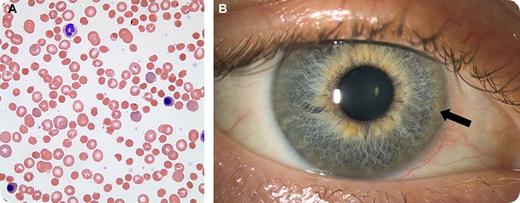A 37-year-old woman with no previous medical problems noted malaise, jaundice, and dark urine that rapidly progressed to severe liver failure. She was referred for an evaluation of anemia. Her hemoglobin was 7.3 g/dL, reticulocyte count 132 000/μL, bilirubin 29.6 mg/dL, lactate dehydrogenase 1834 U/L, and alanine aminotransferase was normal. The blood smear revealed marked spherocytosis, “spur” cells, polychromasia, and nucleated red blood cells (panel A). The serum haptoglobin was undetectable and the direct antiglobulin (Coombs) test was negative. A serum ceruloplasmin was 20 mg/dL (normal, 18-54 mg/dL). The combination of the peripheral smear and evidence of hemolysis with liver failure made Wilson disease a strong consideration. An examination of her eyes revealed Kaiser-Fleischer (KF) rings. Emergency liver transplantation was performed. Her preoperative 24-hour urine later returned showing 2760 μg copper (normal, 3-50 μg). The explant contained copper 1440 μg/g dry weight (normal, 10-35 μg/g). Scleral icterus resolved after surgery. A photograph of the right eye (panel B) shows the KF ring.
During fulminant Wilson disease, nonceruloplasmin copper is abruptly released from the liver and may cause oxidative red cell damage and hemolysis. Short-term plasma exchange may ameliorate the hemolysis. Liver transplantation is preferred therapy because the allograft can produce the missing copper transport protein activity and may “cure” the disease. This patient had a full recovery.
A 37-year-old woman with no previous medical problems noted malaise, jaundice, and dark urine that rapidly progressed to severe liver failure. She was referred for an evaluation of anemia. Her hemoglobin was 7.3 g/dL, reticulocyte count 132 000/μL, bilirubin 29.6 mg/dL, lactate dehydrogenase 1834 U/L, and alanine aminotransferase was normal. The blood smear revealed marked spherocytosis, “spur” cells, polychromasia, and nucleated red blood cells (panel A). The serum haptoglobin was undetectable and the direct antiglobulin (Coombs) test was negative. A serum ceruloplasmin was 20 mg/dL (normal, 18-54 mg/dL). The combination of the peripheral smear and evidence of hemolysis with liver failure made Wilson disease a strong consideration. An examination of her eyes revealed Kaiser-Fleischer (KF) rings. Emergency liver transplantation was performed. Her preoperative 24-hour urine later returned showing 2760 μg copper (normal, 3-50 μg). The explant contained copper 1440 μg/g dry weight (normal, 10-35 μg/g). Scleral icterus resolved after surgery. A photograph of the right eye (panel B) shows the KF ring.
During fulminant Wilson disease, nonceruloplasmin copper is abruptly released from the liver and may cause oxidative red cell damage and hemolysis. Short-term plasma exchange may ameliorate the hemolysis. Liver transplantation is preferred therapy because the allograft can produce the missing copper transport protein activity and may “cure” the disease. This patient had a full recovery.
For additional images, visit the ASH IMAGE BANK, a reference and teaching tool that is continually updated with new atlas and case study images. For more information visit http://imagebank.hematology.org.


This feature is available to Subscribers Only
Sign In or Create an Account Close Modal